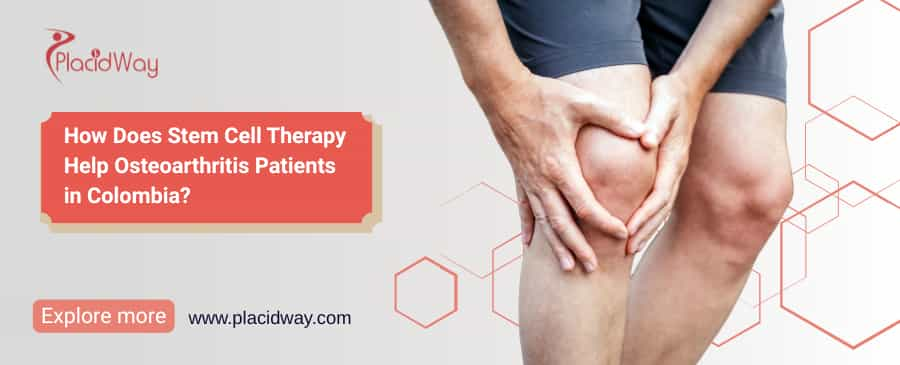Stem Cell Therapy in Colombia: How It Helps Osteoarthritis Patients
"Stem cell therapy helps osteoarthritis patients in Colombia by using the body's natural regenerative abilities to reduce pain, decrease inflammation, and potentially repair damaged cartilage tissue."

Osteoarthritis is a debilitating joint condition that can severely impact a person's quality of life. For many, conventional treatments like physical therapy, medication, and even surgery offer only temporary relief. This has led to a growing interest in regenerative medicine, with stem cell therapy emerging as a promising, non-surgical alternative. Colombia has become a hub for these advanced treatments, drawing patients from around the world. The country’s combination of skilled medical professionals, modern clinics, and competitive pricing makes it an attractive destination. This detailed guide explores exactly how stem cell therapy for osteoarthritis works and the benefits patients can experience in Colombia.
How do stem cells help to treat osteoarthritis?
"Stem cells help treat osteoarthritis by acting as a natural repair system. When injected into a damaged joint, they can differentiate into cartilage-producing cells, reduce inflammation, and release growth factors that promote tissue healing and regeneration."
The primary mechanism of stem cell therapy is not just about replacing damaged cells, but also about creating a healing environment. The injected cells, particularly mesenchymal stem cells (MSCs), are known for their ability to influence the surrounding tissue. They release powerful signaling molecules that reduce the chronic inflammation characteristic of osteoarthritis. This anti-inflammatory action helps to alleviate pain and swelling. Furthermore, these signals encourage the body’s own cells to repair and regenerate damaged cartilage and bone, potentially slowing or reversing the progression of the disease.
What are the main benefits of stem cell therapy for osteoarthritis patients?
"The main benefits of stem cell therapy for osteoarthritis include significant pain reduction, improved joint function and mobility, and a potential for long-term tissue repair, all without the risks and long recovery periods of invasive surgery."
Patients often experience a marked decrease in pain, which is the most common and immediate benefit. This improvement in comfort allows for greater mobility and an increased ability to perform daily activities. Beyond symptomatic relief, a key benefit of regenerative medicine offered at osteoarthritis stem cell clinics in Colombia is its potential to address the root cause of the problem by stimulating tissue regeneration. For many, this offers a more lasting solution than temporary pain management. Additionally, since the procedure is minimally invasive, the recovery time is short, allowing patients to return to their routine much faster than after a major surgical procedure like a joint replacement.
Can stem cell therapy regenerate damaged cartilage?
"While research is ongoing, many studies suggest that stem cell therapy has the potential to help regenerate damaged cartilage. The stem cells release growth factors that stimulate the body’s natural repair processes and may directly differentiate into cartilage-like cells, helping to rebuild the joint's protective layer."
The regenerative capacity of stem cells is one of the most exciting aspects of this treatment. In a healthy joint, cartilage acts as a cushion. In osteoarthritis, this cartilage wears down, leading to bone-on-bone friction. The goal of stem cell therapy is to not only reduce the pain from this friction but to restore the joint's function. The injected stem cells can influence the local environment, providing the necessary signals for new cartilage to grow. This is what sets it apart from traditional treatments that only manage symptoms without addressing the underlying degeneration.
Is stem cell therapy a permanent cure for osteoarthritis?
"Stem cell therapy is not considered a permanent cure for osteoarthritis, as the condition is degenerative. However, it can provide long-lasting relief from pain and can significantly improve joint function for several years, potentially delaying or even preventing the need for joint replacement surgery."
While stem cell therapy is a powerful tool, it does not stop the natural aging process or other factors that contribute to joint degeneration. Its effectiveness and duration of benefits can vary from person to person. However, for many patients, the relief provided is substantial and can last for an extended period. The objective is to restore function and reduce pain to a level where a patient can enjoy a much higher quality of life. It’s best to view it as a highly effective, long-term management strategy rather than a one-time cure.
What is the recovery process like after stem cell therapy?
"The recovery process after stem cell therapy for osteoarthritis is typically short and minimally invasive. Patients may experience minor soreness or swelling at the injection site for a few days, but they can usually return to light activities almost immediately."
The non-surgical nature of the procedure means there is no extensive post-operative care or long rehabilitation period. The procedure involves a simple injection, often guided by ultrasound to ensure precision. Patients are usually advised to rest the treated joint for a day or two and then gradually resume normal activities. Over the following weeks and months, the patient may notice a progressive improvement in pain and function as the stem cells work to regenerate the tissue. Many clinics recommend combining the therapy with a personalized physical therapy plan to optimize results.
Are there any side effects or risks associated with the treatment?
"Stem cell therapy for osteoarthritis is generally considered safe, with the most common side effects being mild and temporary, such as swelling or discomfort at the injection site. More serious risks, like infection or a negative reaction, are rare, especially when the procedure is performed in a reputable clinic with proper protocols."
Because many clinics in Colombia use autologous stem cells (from the patient's own body), the risk of immune rejection is virtually eliminated. However, like any medical procedure, there are minor risks. Patients should always choose a clinic with a strong track record and licensed medical professionals. A thorough consultation can help patients understand the specific risks for their individual case and ensure they are a good candidate for the procedure.
Why do patients choose Colombia for this treatment?
"Patients choose Colombia for stem cell therapy due to its combination of high-quality medical care, affordability, and specialized expertise in regenerative medicine. Many clinics are internationally accredited and staffed by skilled doctors who have extensive experience with the procedure."
Colombia has invested significantly in its medical infrastructure, establishing itself as a top destination for medical tourists. The cost of living and operational expenses are lower than in countries like the United States, which allows clinics to offer advanced treatments at a much lower price. The doctors and medical teams in Colombia are often highly trained and have a strong focus on patient care and safety. Furthermore, many clinics offer comprehensive packages that include everything from consultations to post-treatment follow-up, making the entire process smooth and convenient for international patients.
How can I find a reputable clinic in Colombia for osteoarthritis treatment?
"To find a reputable clinic for osteoarthritis stem cell therapy in Colombia, you should look for clinics with international accreditations, review patient testimonials and before-and-after stories, and have a direct consultation with the medical team to ensure they are transparent about their procedures and success rates."
Research is key. Start by checking for accreditations from international bodies to verify a clinic’s adherence to high standards. Websites and forums dedicated to medical tourism can provide valuable patient reviews and experiences. It is crucial to schedule a virtual consultation with the clinic's medical staff. Use this opportunity to ask detailed questions about the type of stem cells used, the procedure itself, and what to expect in terms of results and recovery. A reputable clinic will be open and willing to provide all the information you need to make an informed decision.
How long does it take to see results after the treatment?
"While some patients may feel minor relief within a few weeks, the full results of stem cell therapy for osteoarthritis can take several months to become fully apparent. The regenerative process takes time, with most significant improvements in pain and function becoming noticeable within three to six months."
The time it takes to see results varies from person to person, as it depends on factors like the severity of the condition, the patient's overall health, and the type of cells used. The stem cells do not provide instant relief like a painkiller. Instead, they work to repair the damaged tissue and reduce inflammation from within. The gradual improvement is a sign that the body is healing. For this reason, patience is an important part of the process, and consistent follow-up with the medical team is recommended to track progress.
Consider exploring solutions with PlacidWay for more information on medical tourism, healthcare services, and finding the right clinic for your needs.


.png)







.jpg)






Share this listing